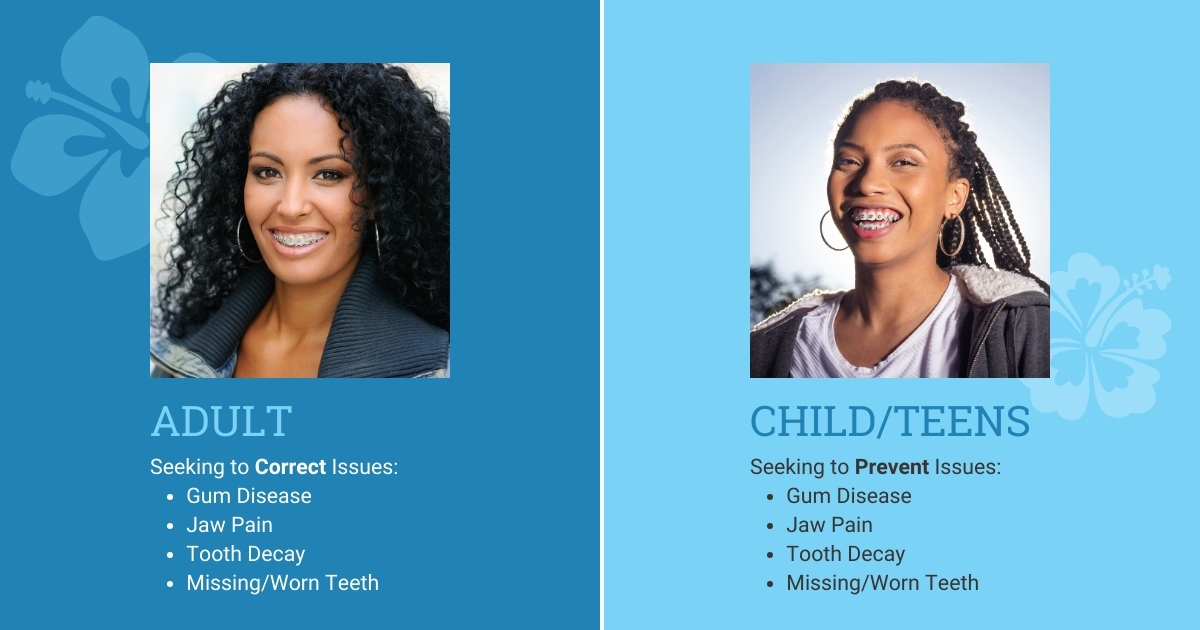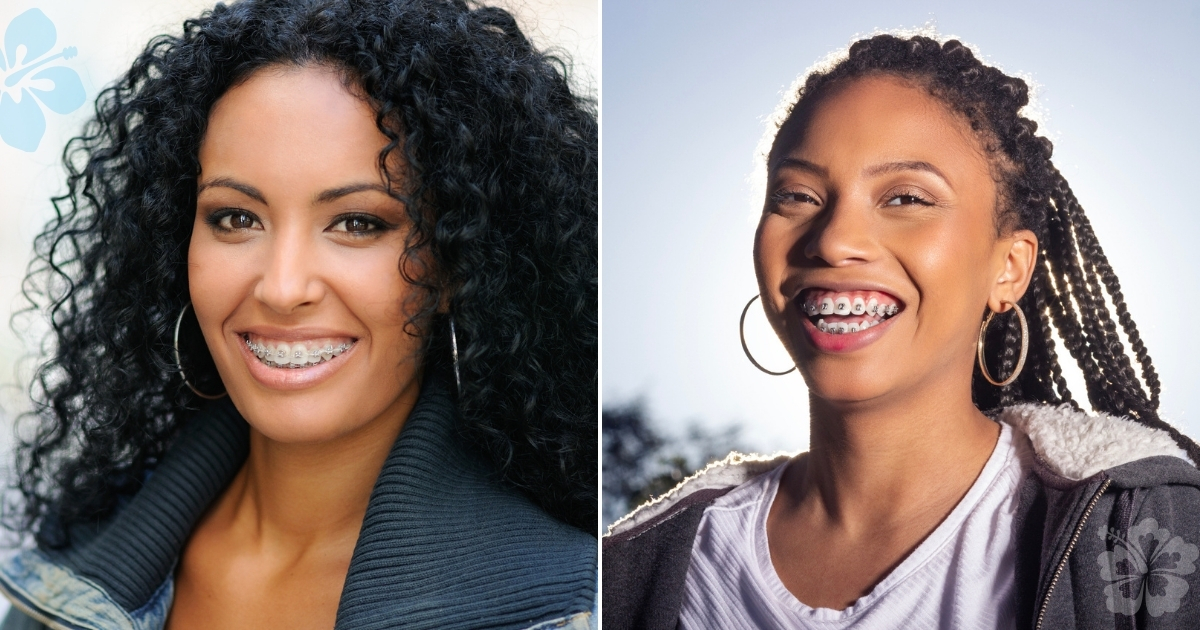Creating the smile of your dreams may seem more out of reach the older you get; however, this is far from true. In fact, although they’re most frequently associated with teens and children, orthodontic treatments have advanced and now provide opportunities for people of all ages to improve their oral health while also boosting self-confidence. Put more simply – treatments are now available for adults, teens, and children.
Let’s explore the most important differences in how the process of realigning teeth can occur at each of these ages.
Orthodontics for Children and Teens
Orthodontic treatments for children are very common. In fact, the recommended age for a first orthodontic appointment can be as early as seven years old. At this point, the jaw bone and ligaments are still malleable and most adult teeth are in place, making it an ideal time to pursue orthodontic treatment if there is an issue.
You May Notice Early Warning Signs
As the jaw and teeth develop, children or their parents may begin to notice oral health issues.
Some early warning signs that appear in children include:
Early or Late Baby Teeth Loss
Losing baby teeth is a completely normal and healthy process. If this occurs too early or too late, however, it can impact the permanent teeth that grow in. An orthodontist can determine the potential impacts on the permanent teeth, whether early or late emergence led to crowding or gaps.
Chewing or Biting Becomes Difficult
If there is frequent pain associated with chewing or biting, this can be an indicator of orthodontic problems like misalignment, gaps, or crowding. While most children experience these symptoms in their teething phase, they should not be permanent or recurring.
Mouth Breathing
Breathing through the mouth cannot be repaired by orthodontic treatments, but it can be an indicator of a greater problem. Sometimes, those who breathe through their mouth as a child are doing so because there are underlying alignment issues that may be helped by an orthodontist.
Clicking or Shifting in the Jaw
Bite problems can cause a child to shift the position of their jaw, which can lead to significant pain. With the help of orthodontic treatments, the alignment can be corrected to reduce or eliminate the pain.
Biting of the Cheek
Cheek biting is often the result of a condition called a crossbite. This is when the upper teeth fail to hold the cheeks back from the lower teeth when chewing. If you notice sore, raw areas in your child’s mouth, a crossbite could be the culprit.
Facial Structure Imbalance
The teeth and jaw play a role in many structural facial features. If the appearance of the lips and chin are imbalanced, this could be a sign that there are orthodontic problems.
Orthodontic Treatment in Children

There are several methods used to treat orthodontic issues in children. They include:
Braces
Braces are used to aid in correcting jaw alignment, crooked teeth, and crowded teeth. Brackets are affixed to the teeth using a special dental glue and then supported with elastic bands resembling small rubber bands. Along with archwires, elastic bands help provide gentle pressure to move the teeth into place. Together, these implements realign the teeth to help the child achieve a properly functioning bite while also creating a more aesthetically pleasing smile.
Aligners
Clear aligners are gaining popularity as they can aid in correcting many orthodontic problems without having to worry about unsightly hardware. These are created from plastic molds that are custom-fitted for the patient’s mouth. They snap into place and gradually readjust the alignment of the teeth. This treatment is designed to work over time by adjusting the teeth 1 millimeter each week.
Retainers
Retainers are used post-orthodontic treatment to help keep the teeth aligned in the new positions. When left unchecked, teeth tend to want to return to their original position. A retainer is put in place to prevent this movement.
Mouthguards
Commonly used in sports, mouthguards can also support orthodontic issues and treatments. Wearing a mouthguard can protect braces and other treatments that may need to be worn. In addition, it can help prevent teeth grinding, which could lead to other issues.
Surgery
In severe cases, surgery could be the best treatment option to help correct teeth alignment, jaw alignment, overcrowded teeth, and many other orthodontic issues.
No matter what orthodontic issue your child could be facing, seeking the advice of an orthodontist at the first sign of trouble can help correct the issue early and prevent long-term issues.
Orthodontics for Adults

For many adults, seeking orthodontic treatments is not something considered feasible or possible. However, it is not only an option but could be the answer for teeth or jaw pain that has lingered for years. According to the American Association of Orthodontics, 1 in 3 three adults seek orthodontic treatment.
While many adults may seek treatment for cosmetic reasons, adults also suffer from a variety of dental problems that can be helped with orthodontic treatment. With the right treatments, adult patients can improve their oral health while also increasing their self-confidence.
Why Do Adults See the Orthodontist?
The reasons adults may seek treatment were often present when they were children.These include:
Overcrowding
Issues with the jaw or a small jaw size can prevent it from having enough space to accommodate the teeth. The result could be overcrowding, which creates places where the teeth could overlap. This misalignment can cause bite issues, impact dental hygiene, and create issues with speech.
Missing Teeth
When children lose baby teeth at the normal age, there is relatively little orthodontic concern. However, when adults lose permanent teeth and do not pursue dental implants or some other solution, the teeth can shift into unnatural places. Orthodontics may be necessary to shift the teeth into their proper position before addressing the missing tooth.
Overbite
When the mouth is closed, the teeth in the upper jaw should align with the teeth in the lower jaw. When the teeth of the upper jaw extend beyond the lower jaw, the result is known as an overbite or deep bite. The longer this is left untreated, the more the teeth wear unevenly, which can cause significant problems in adulthood.
Underbite
The opposite of an overbite, an underbite occurs when the bottom teeth extend beyond the top teeth when the mouth is closed. This type of condition can lead to jaw pain, uneven wear in teeth, and other significant problems.
Open Bite
When the mouth is closed, the teeth should come together evenly. When there is a gap between chewing surfaces, this is known as an open bite. It can impact the ability to chew properly, which can put undue stress on the jaw and other teeth. Correcting this can not only improve aesthetics but also function.
Jaw Pain
Jaw pain is not uncommon in adults. This can be especially true if the wisdom teeth were never removed or are impacting the other teeth. Whether caused by wisdom teeth, severe overcrowding, uneven bite, or other issues, jaw pain can be indicative of orthodontic issues in the mouth.
Tooth Wear and Decay
When teeth are misaligned, it can lead to uneven chewing, causing teeth to wear down unevenly or wear the enamel away from the tooth. This can lead to a greater risk of tooth decay and gum disease. Adults are especially prone to tooth wear and decay, as they have had their teeth much longer.
Gum Disease
This is a common disease in adults that can impact the structures of the teeth as well as the supporting bones in the jaw. As the gums are impacted, they begin to recede and pull the teeth away from their correct position.
Orthodontic Treatment Considerations for Adults
Many of the treatment options available to adults are similar to those available to children and teens. However, a greater number of considerations must be taken into account.
Wear and Tear
As adults have had years of wear and tear on their teeth, the right option may look different for them than for a child with the same issue. An orthodontist must assess the condition of your teeth and may make recommendations based on existing issues, previous dental work, and more.
Extractions and Missing Teeth
Adults are impacted by other factors, such as tooth extractions. In these cases, adults may need to undergo bone implants that can help to fix the gaps before correcting the alignment of teeth. Without this correction, the teeth may naturally move to fill in the gaps.
Jaw Bone Development
Another major consideration is the jaw bone. In children, the bone and the surrounding tissue are still developing and, therefore, will respond to the pressures of treatment differently. A mature jaw bone and supportive structure can make the realignment process more difficult in adult patients, but it is still possible.
Adults seeking treatment will find benefits from several potential options. Braces are by far the most common, but these could be in several forms other than traditional metal braces.
- Ceramic braces are braces crafted from ceramic materials instead of the traditional metal
- Self-ligating braces include a mechanism to tighten and move the position of the teeth on their own, with fewer orthodontic appointments
- Lingual braces can be placed on the inside surface of the teeth
- Clear aligners are often preferred by adults because they are less obvious, but they may take longer to effectively move the teeth
Key Differences Between Adult Orthodontics and Orthodontics for Children/Teens

Orthodontic treatments at any age provide many benefits, including a healthy mouth and a beautiful smile. However, treatment options and the benefits the patient can experience will vary depending on the age of the patient.
When children are provided treatment, it is used as a preventative measure to ensure that they can avoid dental-related problems later in life. Examples of these preventable issues include gum diseases, jaw pain, tooth decay, and more. However, adults may already be experiencing these issues and are seeking treatment to correct them. In addition, in some cases, adults will seek treatment to finish a procedure that was started as a child. Adults may also need to adjust treatments to contend with issues such as missing or worn teeth.
Another key difference between orthodontic treatments for children/teens and those for adults is the use of surgery. While children could need surgery to correct certain conditions, it is much more common for adults to require surgery, particularly when the jaw bones need to be realigned.
Regardless of the age of the patient, an orthodontist can help you determine the right course of action for yourself or your child, bringing a beautiful and pain-free smile to any face.
Benefits of Orthodontic Treatment
Seeking orthodontic treatment is vital for those of any age who require it. It not only improves self-confidence and makes the quality of life patients are seeking more attainable, but it can be instrumental in preventing future dental issues such as gum disease, tooth decay, and more. Oral health is something that should be taken seriously as you age so that you can maintain good oral health.
Orthodontics can provide many specific oral health benefits, including improving jaw function, improving facial structure, maintaining proper bite alignment to ease chewing and eating, and reducing the need for future treatments that could be far more costly. Additionally, treatments can reduce the impacts of tooth decay, meaning you can avoid other dental issues like cavities. When your mouth functions properly, you are also able to more effectively chew foods, which can aid in digestion.
One other major benefit of orthodontic treatments is that you may reduce the risk of temporomandibular joint disorder, more commonly known as TBJ. This is caused by improper biting and chewing, which adds stress to the jaw and causes jaw pain. With the right treatment, this pain may be alleviated.
Robison Orthodontics: Your Child, Teen, and Adult Orthodontist Team

Orthodontic treatments aren’t just for kids. While many may receive treatments at a young age to correct oral issues, some issues may not appear until adulthood or may not need to be corrected until later. As treatments for adults continue to become more common, we urge patients of any age to seek the help they need to correct serious dental health or appearance problems. With an abundance of options available for treatments, no matter what age you are, there are ways to create the smile you have always wanted.
If you are suffering from any type of dental discomfort, seek the help of an orthodontist who can evaluate your teeth to help determine what treatment options are available to you and how those options could help.
At Robinson Orthodontics, our team can help patients of any age through a multitude of treatment options. We want to help ensure your teeth are healthy so that you can have the confidence you need to eat well and smile brightly. Contact us today to request a consultation.

Dr. Tyler Robison is an alum of Mesa’s Mountain View High School. He graduated from Brigham Young University before being accepted to the “Top Ten-nationally ranked” University of Louisville in Kentucky, where he earned his Doctorate in Dental Medicine and a Master’s Degree in Oral Biology. He graduated with honors in the top ten percent of his class. Dr. Robison continued at the University of the Pacific in San Francisco, where he received a second master’s degree in dental science and his orthodontic certification.


